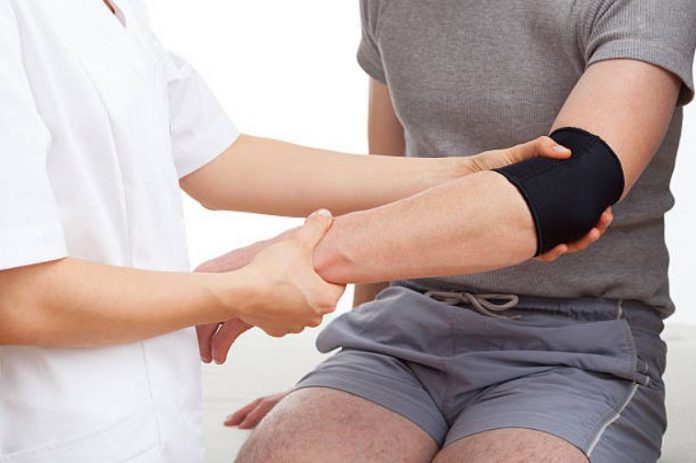Has this ever happened to you? You feel this aching pain in your elbow, all the way down your arm — and the pain just won’t go away.
It hurts when you turn your hand a certain way or when you reach for something across the table. It even hurts when you pick up your coffee cup.
A trip to the doctor and he says you have tennis elbow or lateral epicondylitis. You laugh and say youve never played tennis even once in your life. He must be crazy, right?
Less than 5% of people diagnosed with tennis elbow actually play tennis. Its a repetitive condition that affects people who do the same thing over and over again, using the same hand and arm every time.
People like construction workers, plumbers, cashiers, office workers, or just about anyone who does some form of repetitive work tend to be affected.
It seems to affect people mostly between the ages of 35 and 65, commonly your most productive years in terms of repetitive work.
And it doesn’t discriminate between men and women; both are affected in equal numbers.
Doctors also report that tennis elbow affects your dominant arm about 75% of the time, but there are cases when the non-dominant side can be affected.
For example, in cases where the non-dominant side takes over for the dominant side because of an injury.
What is Tennis Elbow, Really?
The medical name for tennis elbow is lateral epicondylitis. The pain starts on the bony knob located on the outside of your elbow called, strangely enough, the lateral epicondyle.
The muscles from your forearm attach there by a tendon, and that whole area can become inflamed from overuse.
The repeated use of the muscles and tendons in your elbow and forearm from activities such as painting, using small hand tools, gardening, or hammering can cause this form of tendonitis.
Sometimes, the pain associated with tennis elbow isnt a result of inflammation, but rather the wear and tear on the tendon attaching your forearm muscle to your elbow.
In this case its called tendinosis, which is a deterioration of the tendon tissue. It consists of small tears in the tissue that are never allowed to completely heal due to the repetitive action in your wrist, forearm, and elbow.
Common Symptoms of Tennis Elbow
Most doctors describe the symptoms of tennis elbow as:
1. Tenderness and pain starting on the outside of your elbow and radiating down your forearm, sometimes all the way into your middle and ring fingers.
2. The pain is made worse by bending your wrist backward, turning your palm up, grasping something, or holding something with a straight wrist or elbow.
3. Your grip may become weak and painful when you shake hands with someone or turn a doorknob.
4. Pain and discomfort usually lasts from 6 to 12 weeks (but it can last even longer in extreme cases).
There is another repetitive use condition of the elbow that is frequently confused with tennis elbow.
Its called radial tunnel syndrome (RTS), or resistant tennis elbow. Its symptoms are extremely similar to tennis elbow, making its diagnosis sometimes difficult.
In RTS, the radial nerve crossing the elbow is pinched and squeezed as it travels through the radial tunnel, causing pain and weakness similar to tennis elbow.
RTS is suspected when your condition doesnt respond to treatment for tennis elbow. The pain (which is dull as opposed to sharp as in tennis elbow) is often more localized just below the bony knob on the outside of the elbow.
Another symptom may be an increase in pain at night. At that point, your doctor will do other tests to determine if there is a problem with your radial nerve.
What is the Treatment for Tennis Elbow?
In most cases, health professionals recommend conservative treatment, which includes reducing or eliminating the activity causing your pain, use of over-the-counter anti-inflammatory medication (such as Ibuprofen, Motrin, Aleve), ice, massage, and physical therapy exercises to relieve your symptoms.
In more stubborn cases, your doctor may inject your elbow with cortisone, a powerful and direct anti-inflammatory whose benefits can last from a few weeks to several months.
The goal is to reduce the inflammation in your elbow, allowing the tendon to heal.
Some people with tennis elbow have even found relief with alternative therapies such as acupuncture.
If you have not had relief from your symptoms, and have undergone consistent treatment for 6 to 12 months, then you may be one of 5% who need surgery for your tennis elbow. Surgery is usually considered a very last resort.
According to John Cluett, M.D., part of the damaged tendon may be repaired, removed or released, stimulating a healing response in the injured area. The surgery is usually done as an outpatient and symptoms are successfully relieved.
Complete recovery, which includes more physical therapy, can take anywhere from 4 to 6 months, after which most patients report their symptoms completely resolved.
If you suspect you have tennis elbow, don’t put off seeing your doctor. The symptoms usually don’t clear up by themselves and can actually worsen over time without treatment.

